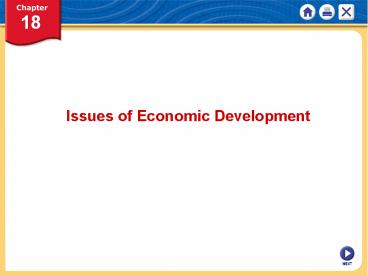Issues of Economic Development - PowerPoint PPT Presentation
Title: Issues of Economic Development
1
Issues of Economic Development
2
Chapter 18 Issues of Economic Development
- A transitional economy is a country that has
moved (or is moving) from a command economy to a
market economy. - Promoting development also promotes good
government and economic opportunity in less
developed countries.
3
3 Major Levels of Development
- Developed Nations
- Developed nations have market economies with
high standard of living - high GDP, industrialization, property ownership,
stable governments - U.S., Canada, Western Europe, Australia, New
Zealand, Japan, South Korea - Most people healthy, educated, with comfortable
lives, urban jobs - Few agricultural workers produce food surplus
through technology
4
3 Major Levels of Development
- Developing Economies
- Transitional economycountry moving from command
to market economy - China, Russia, various Eastern European countries
5
3 Major Levels of Development
- Less Developed Countries
- Less developed countrylower GDP, less industry,
lower living standard - often ineffective or corrupt governments do not
protect property rights - Middle-income Brazil, Thailand low-income
Mozambique, Cambodia - Low-income lack infrastructurebasic support
systems of an economy - people have little education, poor sanitation,
little political freedom
6
Standards of Economic Development
- Per Capita Gross Domestic Product
- Per capita gross domestic productGDP divided by
total population - most popular measure of economic development
- to compare nations, figures adjusted for
difference in cost of products
7
Standards of Economic Development
- Health
- Health and health care statistics help determine
level of development - Infant mortality ratebabies who die in first
year per 1,000 births - low rate is result of good sanitation, health
care, nutrition - Life expectancynumber of years person likely to
live
8
Standards of Economic Development
- Education
- Literacy ratepercent of people over 15 who can
read and write - Percentage of school-age children actually
enrolled an important statistic - Human development index (HDI)combines various
measures - real GDP per capita, life expectancy, literacy
rate, student enrollment
9
Standards of Economic Development
- Consumption of Goods and Services
- How people spend income after food and shelter
indicates development - Increasing consumption of big-ticket items shows
economy growing - also rising living standards
- Less developed nations have more growth potential
for consumer consumption - Today North America, Western Europe 12
population, 60 consumption
10
Standards of Economic Development
- Energy Use
- Electricity, energy contribute to economic
development - Average global electricity consumption 2,744
kilowatt-hours per capita per year - developed nations use over 7,000 less developed
use 750 - Energy used for commerce correlates to technology
use, other measures - Projection to 2025 LDC energy use will rise far
more than developed
11
Standards of Economic Development
- Labor Force
- All economically active people between 15 and 65,
employed or not - More developed nations have
- fewer agricultural workers, more manufacturing
and service workers
12
Reviewing Key Concepts
- Explain the relationship between the terms in
each of these pairs - developed nations and less developed countries
- human development index and infant mortality rate
13
Resources
A Framework for Economic Development Objectives
- Fertile farmland and appropriate climate help
development - Natural resources help
- Also must invest in human and physical capital
for economic expansion
14
Resources
- High Levels of Human Capital
- People most valuable resource in a market economy
- Commitment to education major element of growing
market economy - Educated citizens can make informed decisions for
themselves and children - get health care, vote, take part in civic
affairs, avoid poverty
15
Resources
- High Levels of Physical Capital
- Physical capital, including technology, makes
people more productive - Technology always being refined in developed
nations - LDCs can copy or import
- Copying requires trained people importing
requires foreign investment - investors prefer LDC with human capital
16
Financing Development
- International Help Agencies
- World Bankprovides loans, policy advice,
technical assistance - United Nations Development Program (UNDP)fights
poverty - in 2006 had active programs in 174 nations
17
Financing Development
- International Help Agencies
- International Monetary Fund (IMF)international
organization - promotes monetary cooperation, fosters economic
growth - also gives temporary assistance to ease balance
of payments adjustment - Helps with debt restructuringaltering debt
agreements for advantage - Stabilization programsreforms required of
economy likely to default
18
Financing Development
- Loans and Aid
- External debtmoney borrowed from foreign banks
or governments - has become problem in some countries in South
America, Africa - Defaultnations inability to pay interest or
principle on a loan - Nations may also seek foreign aidmoney from
other nations































